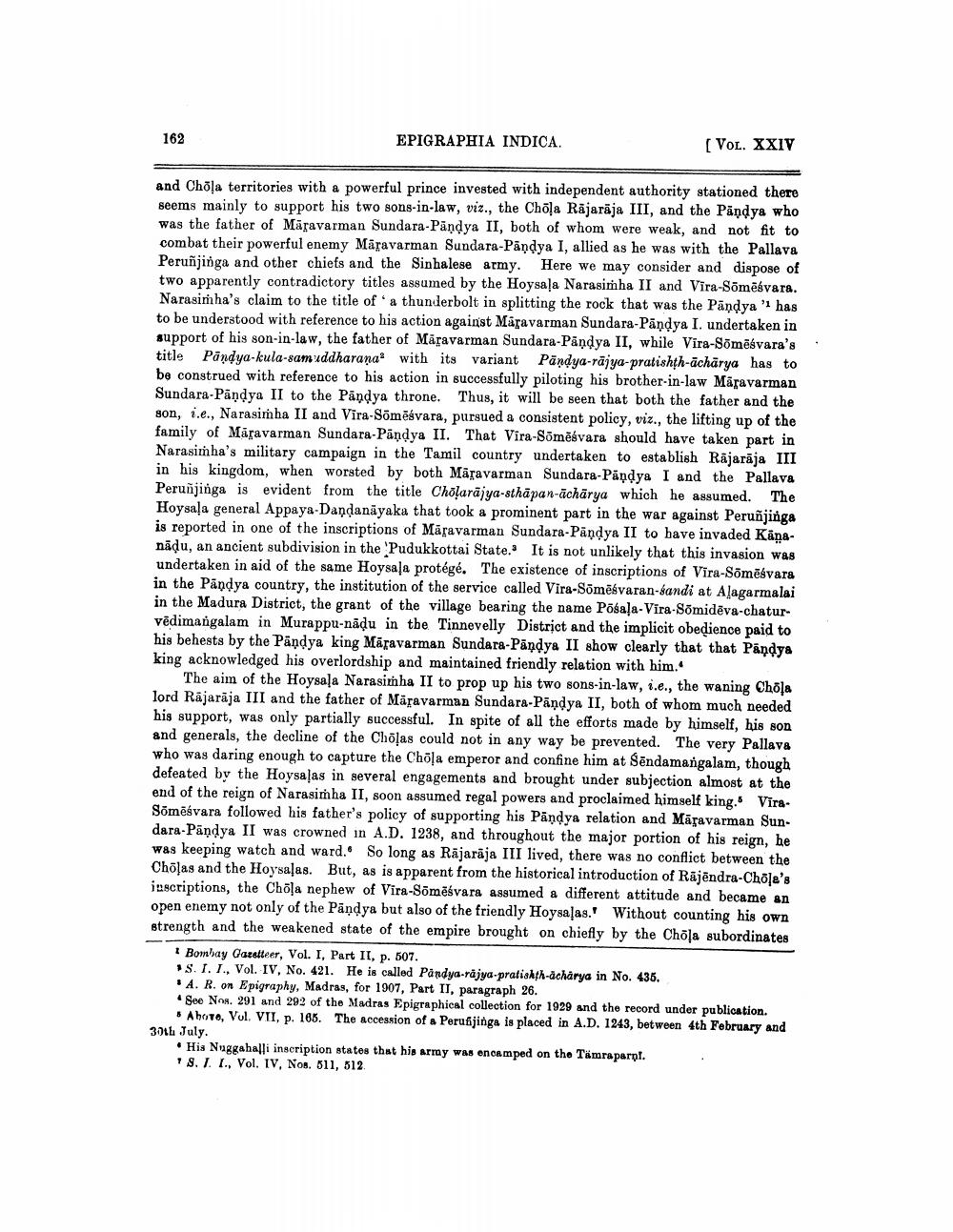________________
162
EPIGRAPHIA INDICA.
[VOL. XXIV
and Chola territories with a powerful prince invested with independent authority stationed there seems mainly to support his two sons-in-law, viz., the Chōla Rajaraja III, and the Pandya who was the father of Märavarman Sundara-Pandya II, both of whom were weak, and not fit to combat their powerful enemy Märavarman Sundara-Pandya I, allied as he was with the Pallava Peruñjinga and other chiefs and the Sinhalese army. Here we may consider and dispose of two apparently contradictory titles assumed by the Hoysala Narasimha II and Vira-Sōmēsvara. Narasimha's claim to the title of a thunderbolt in splitting the rock that was the Pandya ' has to be understood with reference to his action against Maravarman Sundara-Pandya I. undertaken in support of his son-in-law, the father of Maravarman Sundara-Pandya II, while Vira-Sōmesvara's title Pandya-kula-samuddharana with its variant Pandya-rajya-pratishth-acharya has to be construed with reference to his action in successfully piloting his brother-in-law Maravarman Sundara-Pandya II to the Pandya throne. Thus, it will be seen that both the father and the son, i.e., Narasimha II and Vira-Sōmēšvara, pursued a consistent policy, viz., the lifting up of the family of Maravarman Sundara-Pandya II. That Vira-Sōmesvara should have taken part in Narasimha's military campaign in the Tamil country undertaken to establish Rajaraja III in his kingdom, when worsted by both Maravarman Sundara-Pandya I and the Pallava Peruñjinga is evident from the title Chōlarajya-sthapan-acharya which he assumed. The Hoysala general Appaya-Dandanayaka that took a prominent part in the war against Peruñjinga is reported in one of the inscriptions of Maravarman Sundara-Pandya II to have invaded Kananādu, an ancient subdivision in the 'Pudukkottai State. It is not unlikely that this invasion was undertaken in aid of the same Hoysala protégé. The existence of inscriptions of Vira-Sōmēsvara in the Pandya country, the institution of the service called Vira-Sōmēśvaran-sandi at Alagarmalai in the Madura District, the grant of the village bearing the name Põsala-Vira-Somideva-chaturvedimangalam in Murappu-nadu in the Tinnevelly District and the implicit obedience paid to his behests by the Pandya king Maravarman Sundara-Pandya II show clearly that that Pandya king acknowledged his overlordship and maintained friendly relation with him."
The aim of the Hoysala Narasimha II to prop up his two sons-in-law, i.e., the waning Chōla lord Rajaraja III and the father of Maravarman Sundara-Pandya II, both of whom much needed his support, was only partially successful. In spite of all the efforts made by himself, his son and generals, the decline of the Chōlas could not in any way be prevented. The very Pallava who was daring enough to capture the Chola emperor and confine him at Sendamangalam, though defeated by the Hoysalas in several engagements and brought under subjection almost at the end of the reign of Narasimha II, soon assumed regal powers and proclaimed himself king. ViraSomesvara followed his father's policy of supporting his Pandya relation and Maravarman Sundara-Pandya II was crowned in A.D. 1238, and throughout the major portion of his reign, he was keeping watch and ward. So long as Rajaraja III lived, there was no conflict between the Cholas and the Hoysalas. But, as is apparent from the historical introduction of Rajendra-Chōla's inscriptions, the Chōla nephew of Vira-Someśvara assumed a different attitude and became an open enemy not only of the Pandya but also of the friendly Hoysalas. Without counting his own strength and the weakened state of the empire brought on chiefly by the Chōla subordinates
1 Bombay Gazetteer, Vol. I, Part II, p. 507.
S. I. I., Vol. IV, No. 421. He is called Pandya-rajya-pratishth-acharya in No. 435.
A. R. on Epigraphy, Madras, for 1907, Part II, paragraph 26.
See Nos. 291 and 292 of the Madras Epigraphical collection for 1929 and the record under publication. Above, Vol. VII, p. 165. The accession of a Perufijinga is placed in A.D. 1243, between 4th February and 30th July.
His Nuggahalli inscription states that his army was encamped on the Tämraparp!. S. I. I., Vol. IV, Nos. 511, 512




